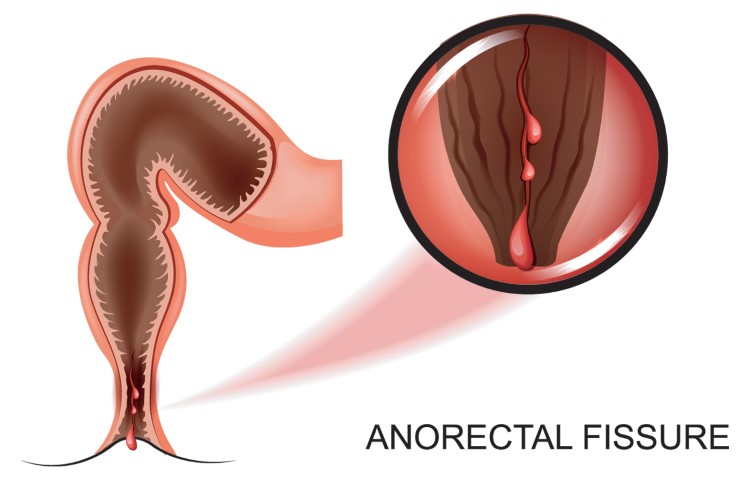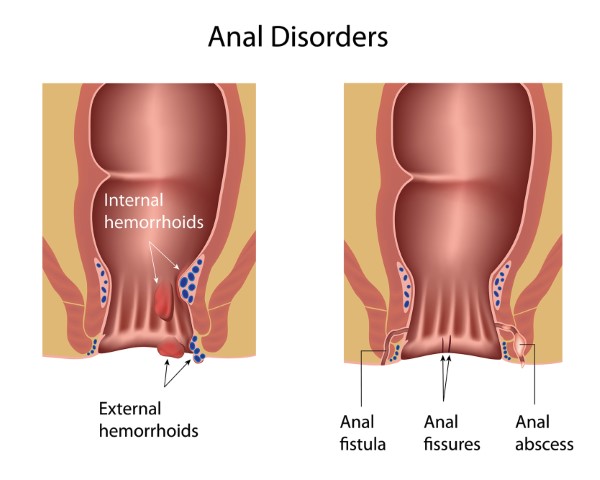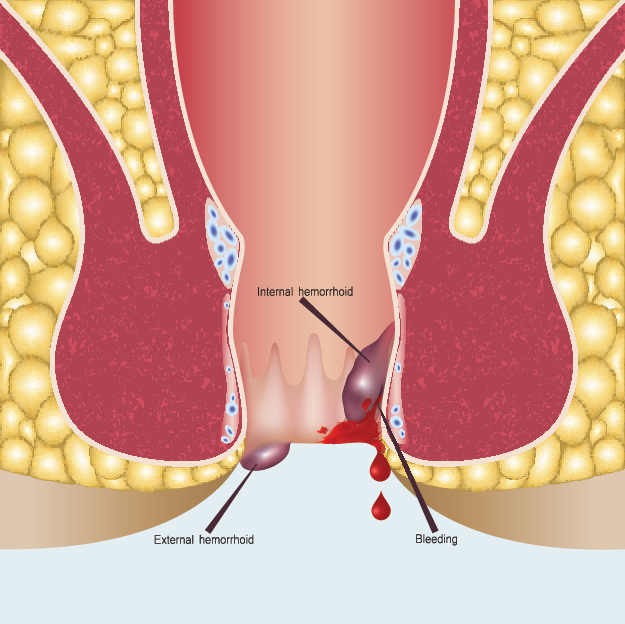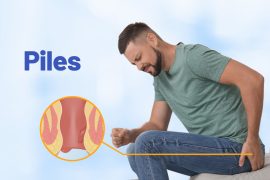What are Piles/Hemorrhoids?
Piles, also known as Hemorrhoids, are a collection of swollen tissues and veins in your anus and lower rectum. They can be of two types – internal and external. Internal hemorrhoids develop inside the anal canal, while external hemorrhoids develop on the skin around the anus. These hemorrhoids may vary in size. Piles may occur due to constipation, chronic diarrhea, lifting heavy weights, pregnancy, and straining while passing stools.
Usually, hemorrhoids don’t require any treatment and resolve on their own. But when the condition turns severe, treatment is needed. The symptoms of piles depend on the type and location. In the case of external hemorrhoids, the symptoms might include irritation/itching in the anal region, pain, discomfort, swelling, and bleeding. In the case of internal hemorrhoids, the hemorrhoids cannot be seen, but they can cause painless bleeding while passing stools. Protruding hemorrhoids have feeling of some mass in the anal region that causes pain and irritation.
What are the various treatment/cure methods for Piles?
There are different ways to cure piles, depending on the severity of it. Some of the most effective treatment methods are:
For early and mild pile piles:
Home Remedies: If the hemorrhoids are mild, then you can cure them through certain home remedies such as making dietary and lifestyle changes, using over-the-counter hemorrhoid cream containing hydrocortisone, and soaking your anal area in warm water for 10-15 minutes every day.
Rubber Band Ligation: In this procedure, your doctor will place one or two tiny rubber bands on the base of the internal hemorrhoids to stop the circulation. Within a week, the hemorrhoid withers and falls off.
Sclerotherapy: Your doctor will inject a chemical into hemorrhoid to shrink it. Though this procedure causes less pain, it is also less effective than the rubber band ligation.
Coagulation: This technique uses laser or infrared light to harden internal hemorrhoids that bleed, shriveling them.
For moderate to severe piles:
External Hemorrhoid Thrombectomy: In case of thrombosis (a painful blood clot) in external hemorrhoid, your doctor will remove hemorrhoid, which will provide immediate relief. This procedure is done under local anesthesia and is extremely effective if performed within 72 hours of the blood clot.
Hemorrhoid Removal: Also known as Hemorrhoidectomy, this is a surgical procedure in which the surgeon removes the excess tissue which is protruding out of anal canal that causes bleeding. This method is used to treat severe piles.
Hemorrhoid Stapling: This procedure is also known as Stapled hemorrhoidopexy. It blocks the blood flow to the hemorrhoid tissue by taking cutting and pulling the piles up on its position. It is usually used to treat internal hemorrhoids.
What is Anal Fissure?



An anal fissure is a tear in the mucosa (a thin, moist tissue) lining of the anus. The tearing of the skin causes severe pain and bleeding during and even after bowel movements. Though it is most commonly seen in infants and children, an anal fissure can affect people of all age groups. Most times, the fissure heals on its own with a month to six weeks. But if it persists after that, it can be considered chronic. Sometimes, the fissure tends to be deep enough to expose the muscle tissue.
The most common causes of an anal fissure are constipation, straining during bowel movements, passing large/hard stools, diarrhea, childbirth, and anal intercourse. A person suffering from an anal fissure may experience one or more of the following symptoms, which include, mild/severe pain during bowel movements, visible tear/crack on the skin around the anus, a small lump near the tear, streaks of blood after passing stools on the toilet seat or the tissue paper, pain after bowel movements that lasts for a long time.
How can Anal Fissure be cured?
Usually, Anal Fissure doesn’t require extensive treatment. Certain home remedies can help cure anal fissure and relieve symptoms. Some treatment methods to cure anal fissure are:
Home remedies: You can take measures to keep your stools soft, such as increasing the intake of fibers and fluids, and taking a sitz bath to relax the anal muscles, relieve irritation, and increase blood flow.
Applying Nitroglycerin: Applying a nitroglycerin cream or ointment will help increase blood flow to the anal area and reduce inflammation.
Botox Injection: The Botulinum toxin type A (botox) injection may help paralyze the anal sphincter muscle and relax the spasms.
Blood Pressure Medicines: These medicines can also help relax the anal muscle. This can be used when nitroglycerin is not effective or causes significant side effects.
Surgery: If the anal fissure is severe, your doctor might suggest surgery known as the Lateral Internal Sphincterotomy (LIS), in which a small portion of the anal sphincter muscle will be removed to reduce pain and promote healing.
What is the difference between Piles and Fissure?
While piles are a collection of swollen tissues in and around the anus region, fissure refers to a crack in the anal cavity.
What is Anal Fistula?
An anal fistula is a small tunnel that develops between the anal canal and the skin near the anus. They’re usually the result of an infection near the anus causing a collection of pus (abscess) in the nearby tissue. When the pus drains away, it can leave a small channel behind. In the fistula, the center portion of the anus gets infected and forms an abscess, which starts oozing pus.
What is the difference between Piles and Fistula?
Piles are caused due to constipation, diarrhea, pregnancy, and weight lifting, while fistula is caused due to trauma, Crohn’s disease, warts or cancer. Piles can usually be diagnosed by self by observing the signs and symptoms while detecting fistula might be difficult and may require an MRI scan or a sonofistulagram.
Piles are less severe as they can be cured with home remedies and other less invasive techniques, while fistula can only be treated through surgeries such as fistulotomy, seton techniques, advancement flap procedure, and LIFT procedure. Video-Assisted Anal Fistula Treatment (VAAFT) is a non-surgical method commonly used to treat fistula.



Be it piles, anal fissures or fistula, the first step to prevent them is by practicing better hygiene, especially when it comes to defecation. All three conditions can also be prevented by indulging in a high-fiber diet and increasing the intake of fluids, everyday physical activities and avoiding strains. It is also important for one to be mindful of the symptoms and seek immediate medical help to prevent the conditions from becoming severe.
Disclaimer: This blog is only for awareness purpose. We do not intent to promote any medications given in the blog. Please consult your physician before taking any medication.




